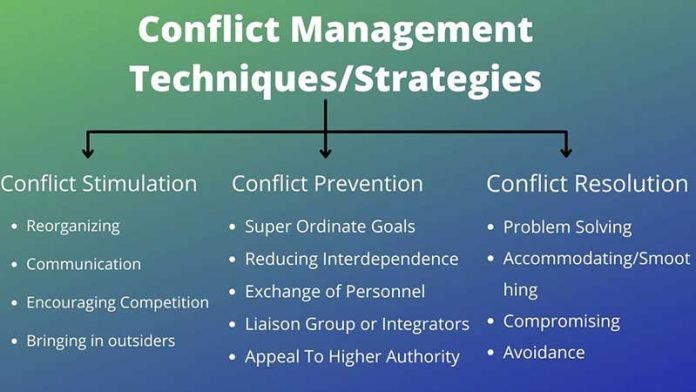Introduction
Conflict is an inevitable part of life, and it can arise in various situations, from personal relationships to workplace disputes. Conflict can be defined as a disagreement or difference of opinion between two or more parties. Conflict can be positive or negative, and it can lead to growth and development or can escalate into a destructive force that can cause harm to individuals or groups. Conflict resolution is the process of finding a solution to a conflict, and it is essential to promote a peaceful and harmonious environment. In this article, we will explore conflict management techniques and strategies that can be used to resolve conflicts effectively.
What is Conflict Resolution, and Why is it Important?
Conflict resolution is the process of finding a peaceful and mutually satisfactory solution to a conflict. It involves the identification and analysis of the problem, the exploration of workable solutions, and the selection and implementation of the most appropriate solution. Conflict resolution is essential because it promotes cooperation, understanding, and respect between individuals and groups. It helps to prevent escalation of conflicts and violence, enhances communication and relationships, and promotes a positive and healthy environment.
Types of Conflict Resolution
There are three types of conflict resolution: behavioural, structural, and relational.
Behavioural Conflict Resolution
Behavioural conflict resolution focuses on addressing the specific behaviours that are causing the conflict. It involves identifying the behaviours that are problematic and developing strategies to modify or eliminate them. This type of conflict resolution is useful in situations where the conflict is caused by specific actions, such as bullying or harassment.
Structural Conflict Resolution
Structural conflict resolution focuses on the underlying structural factors that contribute to the conflict. It involves examining the policies, procedures, and systems that are in place and making changes to address the root causes of the conflict. This type of conflict resolution is useful in situations where the conflict is caused by systemic issues, such as discrimination or inequality.
Relational Conflict Resolution
Relational conflict resolution focuses on the interpersonal relationships between the parties involved in the conflict. It involves exploring the underlying emotions, values, and beliefs that are driving the conflict and developing strategies to address them. This type of conflict resolution is useful in situations where the conflict is caused by a breakdown in communication or trust between individuals or groups.
Different Ways to Manage Conflict
There are diverse ways to manage conflict, depending on the situation and the parties involved. The most common conflict management techniques are negotiation, mediation, and arbitration.
Negotiation
Negotiation is a process of discussion and compromise between two or more parties to find a mutually satisfactory solution to a conflict. It involves the exchange of ideas and proposals, and the parties work together to reach a compromise that satisfies their interests. Negotiation is useful in situations where the parties have a common goal and are willing to work together to find a solution.
Mediation
Mediation is a process in which a neutral third party helps the parties involved in a conflict to find a mutually satisfactory solution. The mediator facilitates communication between the parties and helps them to identify the underlying issues that are causing the conflict. The mediator does not make decisions for the parties but helps them to reach an agreement that is acceptable to both. Mediation is useful in situations where the parties have an elevated level of conflict, and communication between them is difficult.
Arbitration
Arbitration is a process in which a neutral third party decides about a conflict that is binding on the parties involved. The arbitrator listens to the arguments and evidence presented by both parties and reaches a decision based on the facts of the case. The decision of the arbitrator is final and cannot be appealed. Arbitration is useful in situations where the parties are unable to reach a mutually satisfactory solution and need a third party to make a decision for them.
Types of Conflict Management
There are five types of conflict management: avoidance, accommodation, competition, collaboration, and compromising.
Avoidance
Avoidance is a conflict management technique in which one or both parties avoid addressing the conflict. This can involve ignoring the conflict, denying its existence, or withdrawing from the situation. Avoidance can be useful in situations where the conflict is minor or when addressing the conflict may cause more harm than good. However, if avoidance is used too often, it can lead to a build-up of unresolved conflicts, which can create a more significant problem in the future.
Accommodation
Accommodation is a conflict management technique in which one party agrees to give up their position or preferences to satisfy the other party’s needs. This can involve compromising, conceding, or sacrificing personal goals to maintain peace and harmony. Accommodation can be useful in situations where the issue is minor, and the relationship between the parties is more important than the outcome of the conflict. However, if accommodation is used too often, it can lead to a loss of personal identity and self-respect.
Competition
Competition is a conflict management technique in which the parties involved in the conflict attempt to win the argument or gain an advantage over the other party. This can involve using aggressive or confrontational behaviour, such as yelling, accusing, or blaming the other party. Competition can be useful in situations where the parties have a prominent level of confidence and are willing to assert their position. However, if competition is used too often, it can escalate the conflict and damage the relationship between the parties.
Collaboration
Collaboration is a conflict management technique in which the parties work together to find a mutually satisfactory solution to the conflict. This can involve sharing ideas, exploring different options, and building consensus around a common goal. Collaboration can be useful in situations where the parties have an elevated level of trust and are willing to listen to each other’s perspectives. Collaboration can lead to innovative solutions that satisfy both parties’ interests, and it can strengthen the relationship between the parties.
Compromising
Compromising is a conflict management technique in which the parties reach a mutually satisfactory solution by finding a middle ground or a shared solution. This can involve giving up part of one’s position or preferences in exchange for the other party’s cooperation. Compromising can be useful in situations where the parties have a moderate level of conflict and are willing to find a solution that satisfies both parties’ interests. Compromising can lead to a quick resolution of the conflict, but it may not satisfy either party completely.
Conclusion
Conflict is an inevitable part of life, and it can arise in various situations, from personal relationships to workplace disputes. Conflict resolution is the process of finding a peaceful and mutually satisfactory solution to a conflict, and it is essential to promote a peaceful and harmonious environment. There are several types of conflict resolution, including behavioural, structural, and relational, and there are diverse ways to manage conflict, including negotiation, mediation, and arbitration. There are also different conflict management techniques, including avoidance, accommodation, competition, collaboration, and compromising. Choosing the most appropriate conflict management technique depends on the situation and the parties involved. Understanding the different conflict management techniques and strategies can help individuals and groups to resolve conflicts effectively and create a positive and healthy environment.
Twenty positive affirmations to help someone trying to resolve a conflict:
- I can find a peaceful solution to this conflict.
- I approach this conflict with an open mind and an open heart.
- I am willing to listen to the other party’s perspective.
- I choose to focus on finding a solution rather than blaming others.
- I trust that we can find a resolution that satisfies both parties.
- I am confident in my ability to communicate effectively and respectfully.
- I approach this conflict with a spirit of collaboration and cooperation.
- I am willing to consider creative solutions to resolve this conflict.
- I remain calm and centered during conflict.
- I am committed to finding a resolution that is fair and just for everyone involved.
- I am patient and persistent in finding a resolution to this conflict.
- I am willing to forgive and let go of any past hurts or resentments.
- I am grateful for the opportunity to learn and grow from this conflict.
- I choose to approach this conflict with compassion and empathy.
- I am willing to take responsibility for my role in the conflict.
- I choose to focus on finding common ground rather than differences.
- I trust that we can find a solution that benefits everyone involved.
- I am open to feedback and willing to learn from this experience.
- I am confident that we can resolve this conflict in a way that strengthens our relationship.
- I choose to approach this conflict with a positive and optimistic mindset.
Remember, positive affirmations are not a magic solution to resolving conflict. However, they can help to shift your mindset and give you the strength and courage to approach the conflict with a positive and proactive attitude. With patience, persistence, and a willingness to collaborate, you can find a resolution that benefits everyone involved.
References:
- Folger, J. P., Poole, M. S., & Stutman, R. K. (2013). Working through conflict: Strategies for relationships, groups, and organizations. Routledge.
- Pruitt, D. G., & Carnevale, P. J. (Eds.). (2015). Negotiation in social conflict. Psychology Press.
- Galtung, J. (2016). Conflict transformation and peacebuilding: Moving from violence to sustainable peace. Routledge.
- De Dreu, C. K., & Gelfand, M. J. (Eds.). (2008). The psychology of conflict and conflict management in organizations. Routledge.
- Rahim, M. A. (2002). Toward a theory of managing organizational conflict. The International Journal of Conflict Management, 13(3), 206-235.
- Deutsch, M. (1973). The resolution of conflict: Constructive and destructive processes. Yale University Press.
- Lewicki, R. J., Saunders, D. M., & Barry, B. (2010). Negotiation. McGraw-Hill.
- Moore, C. W. (2014). The mediation process: Practical strategies for resolving conflict. John Wiley & Sons.
- Fisher, R., Ury, W., & Patton, B. (2011). Getting to yes: Negotiating agreement without giving in. Penguin.
- Wall, J. A., Callister, R. R., & Turban, D. B. (1999). Implications of relational demography for bicultural individuals and their work groups. Journal of Applied Psychology, 84(6), 1074-1087.



